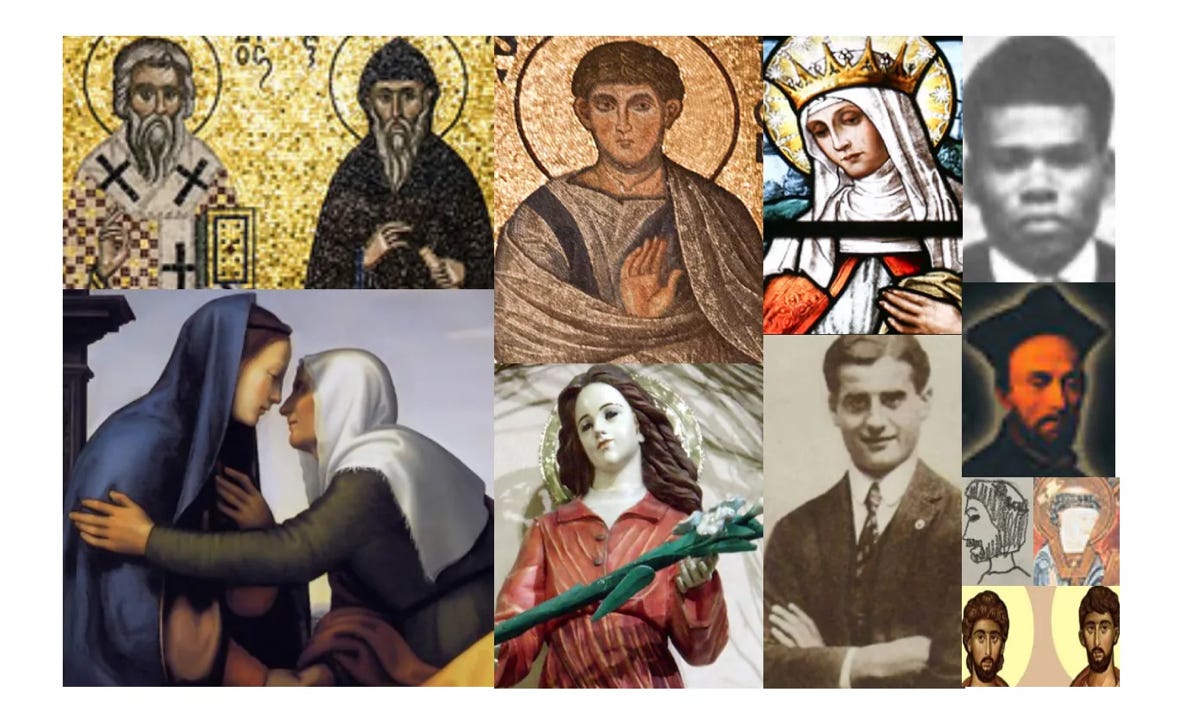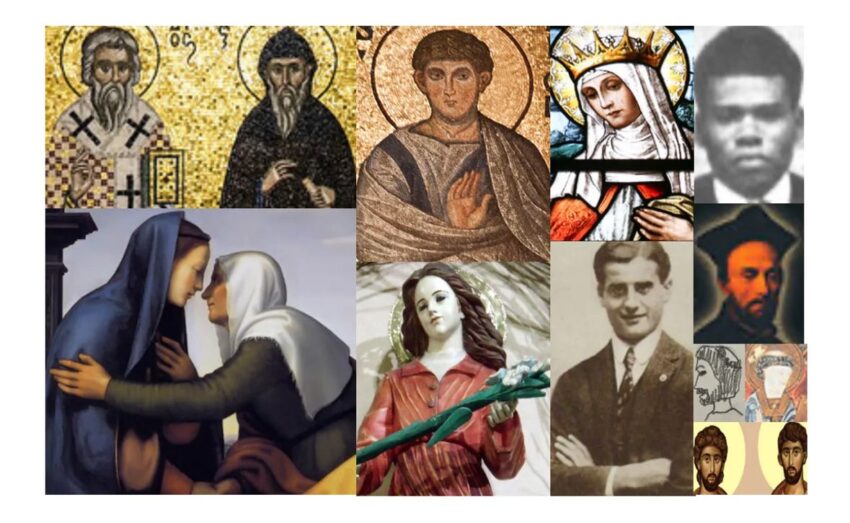
Today is the feast of St. Killian, a great Irish missionary and martyr. To a greater or lesser degree, each of us is called to be a missionary, spreading the Gospel to others, as the saints we celebrated this week did.
St. Thomas the Apostle (July 3) is often called “the doubter” because he doubted the truth of the Resurrection, but the Gospels show him multiple times expressing great loyalty to and faith in Jesus, most notably his exclamation upon meeting the Resurrected Jesus (20:28): “My Lord and My God!” After the Ascension, Thomas evangelized in India and was martyred there; there is still a Christian community there that can trace its roots back to Thomas.
July 2 is the Latin Mass commemoration of Mary’s Visitation to her cousin St. Elizabeth after they both became miraculously pregnant—Elizabeth with John the Baptist and Mary with Jesus the Messiah (see Luke 1:39-55). Mary recited her beautiful Magnificat canticle. Read more here. Another Marian commemoration July 2 was the Deposition of the relic of the Venerable Robes of the Theotokos (Mary). Our Lady of Akita (July 6) was an apparition of Mary in Japan.
St. Maria Goretti (July 6) was an Italian farm girl whose family moved onto the Serenelli farm after her father’s death. In 1902, Alessandro Serenelli, 19 years’ old, tried to rape 12-year-old Maria, who fought him and cried out it was a sin as he stabbed her 14 times. She forgave him before she died, and converted him by appearing in a vision; he testified to her cause for beatification.
St. Elizabeth of Portugal (July 4) was married at age 12 to King Denis of Portugal, a womanizer. Besides helping the poor, Elizabeth converted her husband and made peace between her warring son and son-in-law (d.1336). Bl. Pier Giorgio Frassati (July 4) was a pious Italian youth who joined the St. Vincent de Paul Society and Catholic Action, cared for the poor, and studied mining engineering. A lover of practical jokes, sports, and mountain climbing. He was not allowed to marry the woman he loved and died young in 1925.
Bl. Peter To Rot (July 7) was a 20th century husband and father in Papua New Guinea, a catechist who assisted missionaries. During WWII, the Japanese occupied the island, persecuted Christians, and tried to reintroduce polygamy. Peter protested and was imprisoned and suffocated to death by the Japanese. Bl. Ralph Milner (July 7) was an English layman and father imprisoned for the faith but allowed to leave prison during which time he assisted priests. He was hanged, drawn, and quartered in 1591.
Sts. Cyril and Methodius (July 7, Latin Mass) were Greek nobles who became priests and missionaries to Russian Jews. Later they developed the Cyrillic alphabet for Slavic and began the practice of saying Divine Liturgy (Mass) in the Slavonic language. After his brother Cyril’s death in 869, Methodius became an archbishop, continued to evangelize the Czechs, Moravians, Bohemians, Pannonians, and Poles, and translated the Bible into Slavonic.
St. Anthony Mary Zaccaria (July 5) was a Lombardy physician who became a priest; angels appeared at his first Mass. A preacher and administrator, he founded the Barnabites and Angelics of Saint Paul, encouraged lay apostolate, and helped introduce the Forty Hours’ Devotion (d.1539). St. Anthony Daniel (July 4) was a French Jesuit missionary who founded a school for Huron natives in Canada. He was captured and martyred by Iroquois in 1648.
Sts. Processus and Martinian (July 2) were early Roman martyrs, possibly the keepers of the prison of Sts. Peter and Paul. St. Swithun or Swithin (July 2) was a chaplain to the West Saxons’ king, tutor to the prince, and royal counselor. Later bishop of Winchester, known for building churches and helping the poor; popular in England.
Bl. Petrus Kasui Kibe (July 4) was the first Japanese pilgrim to enter Jerusalem and a priest who was martyred in 1639. St. Romulus of Fiesole (July 6), converted by St. Peter, became the first bishop of Fiesole and was martyred c.90 with Carissimus, Dulcissimus, and Crescentius. St. Febronia of Patti (July 5) was a convert who refused an arranged marriage and was drowned by her angry father in the 4th century. St. Anatolius of Alexandria (July 3) was a Bishop, Scholar, Scientist, Philosoper, Computist, Mathematician, and Writer (d.283). St. Andrew of Crete (July 4) was a theologian, homilist, and hymnographer who developed the canon (d.c.740). Pope St. Leo II (July 3) was a musician and opponent of heresy during his brief 7th century reign. Bl. Patrick Cavanagh (July 5) was an Irish sailor martyred in 1581.
St. Marthe (July 5), mother of St. Simeon Stylites the Younger, was a 6th century mystic in Syria. St. Marcus Ji Tianxiang(July 7) was a doctor—and an opium addict, who nevertheless died bravely as a martyr in the Boxer Rebellion. St. Sisoes the Great(July 6) was a desert monk, hermit, and miracle-worker in Egypt (d.c.430). Bl. Thomas Alfield (July 6) was an English priest who denied the faith, repented, and was martyred in 1585. St. Bernadino Realino (July 2) was an Italian lawyer, judge, and official who became a popular Jesuit priest; asked before his 1616 death to be Lecce’s patron saint. St. Willibald of Eichstätt (July 7) was an Anglo-Saxon bishop and wandering pilgrim across several continents in the 8th century. St. Athanasius the Athonite (July 5) was a hermit, Bible scholar, monastery founder, and friend to the Byzantine emperor (d.c.1003). St. Palladius of Ireland (July 6) was a Gallo-Roman missionary bishop in 5th century Ireland and Scotland.
St. Teresia Chen Qingjieh (July 5) was a Chinese laywoman martyred in the 1900 Boxer Rebellion. Pope St. Benedict XI (July 7) was an Italian Dominican who restored peace with the French court (d.1304). St. Anatolius of Constantinople (July 3) was a 5th century Patriarch who played a key role in the Council of Chalcedon. St. Eusebius of Laodicea (July 3) was a deacon and then bishop who opposed heresy and helped persecuted Christians (d.c.268). St. Gunthiern (July 3) was a Welsh prince who became a hermit. Bl. Catherine Jarrige(July 4) cleverly hid priests during the French Revolution. St. Ulric of Augsburg(July 4) was a Swiss bishop who held off the plundering Magyars. Bl. Jozef Kowalski(July 4) was a Polish priest martyred by Nazis in Auschwitz in 1942. Bl. Juan Antonio Pérez Mayo (July 7) was a Spanish Missionary Oblate and priest martyred in the Spanish Civil War in 1936.
Also this week were Peter of Metz, Monegundis, Jacques Fermin, Pietro and Giovanni Becchetti, Lidanus of Sezze, Eugénie Joubert, Benedict Metzler, and Jarich of Mariegaarde (July 2); Heliodorus of Altinum, Giuse Nguyen Ðình Uyen, German of Man, Raymond of Toulouse, Ioannes B. Zhao Mingxi, Philiphe Phan Van Minh, Petrus Zhao Mingzhen, Barbara Jeong Sun-Mae, and Andreas Ebersbach(July 3); John Cornelius, Cesidio Giacomantonio, Bertha of Blangy, Giovanni daVespignano, Natalia of Toulouse, Maria Ripamonti, Carileffo, Laurian of Seville, William of Hirsau, and Patrick Salmon (July 4).
You can also read about Domèce, George Nichols, Zoe of Rome, Elias of Bourdeilles, Thomas Belson, Fragan and Gwen, Cyrilla of Cyrene, and Rosa Chen Aijieh (July 5); Dominica of Campania, Goar of Aquitaine, Tranquillinus of Rome, Maria T. Ledóchowska, Suzanne-A.Deloye, Saxburgh of Ely, Augustin-J. Desgardin, Petrus Wang Zuolung, Cyril of Thessaloniki, Macrine of Niort, and Noyala (July 6); and Ethelburga of Faremoutier, Maelruan, Apollonius of Brescia, Joseph Juge, Antonino Fantosati, Pantaenus, Oddino Barrotti, Juan Pedro, Roger Dickinson, Maria R.Meneses, Odo of Urgell, and Marie-Gabrielle-Françoise-Suzanne (July 7).
Have a blessed week!
Click this link for the original source of this article.
Author: Catherine Salgado
This content is courtesy of, and owned and copyrighted by, https://catherinesalgado.substack.com and its author. This content is made available by use of the public RSS feed offered by the host site and is used for educational purposes only. If you are the author or represent the host site and would like this content removed now and in the future, please contact USSANews.com using the email address in the Contact page found in the website menu.








